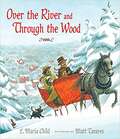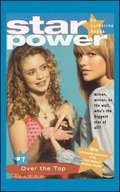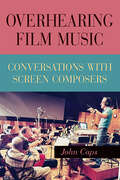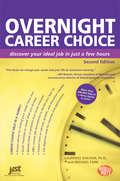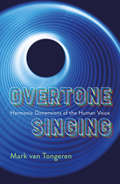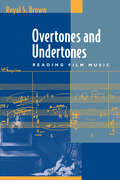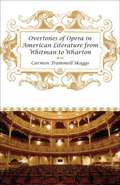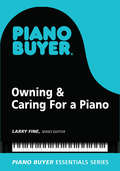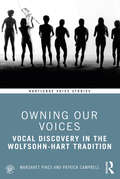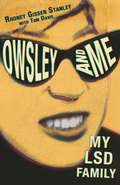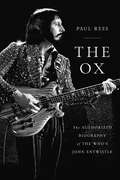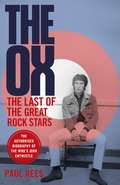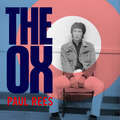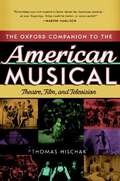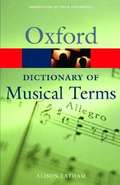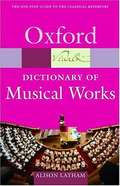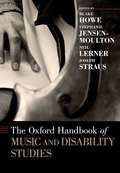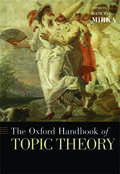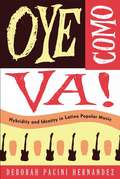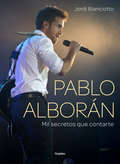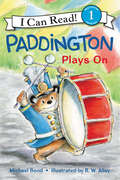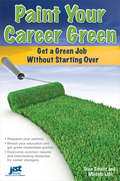- Table View
- List View
Over the River and Through the Wood: A Thanksgiving Poem
by Lydia Maria ChildOver the river and through the wood, To Grandfather's house we go . . . FOR NEARLY 150 YEARS the words of Lydia Maria Child's Thanksgiving poem have been as essential a part of the traditional holiday celebration as turkey and pumpkin pie.
Over the Top (Star Power)
by Catherine HapkaCan the answer to Star's dreams be found in a crystal ball? Star and her team attend an industry event in London, where they run into Jade, Eddie Urbane, and his latest girlfriend, New Age guru Xandra. When Xandra says she's psychic and gives Star some shocking news about Star's parents, Star isn't sure what to believe -- after all, with Eddie around, trouble is never far behind! Still, Star can't resist following up just in case. To get to the bottom of things, she goes to the most unlikely person for help -- and the results are more shocking than Star could have imagined.
Overhearing Film Music: Conversations with Screen Composers (SUNY series, Horizons of Cinema)
by John CapsBeginning with a quick history of film scoring and then taking the reader backstage to interview a dozen major screen composers, Overhearing Film Music represents three generations of movie soundtrack music. Ranging from groundbreaking composers who scored classic 1940s melodramas such as Laura and the Thief of Bagdad, to the jazz-influenced modernists who worked on Rebel Without a Cause and The Pink Panther, and into the symphonic renaissance represented by films like Star Wars and Harry Potter, Caps asks the seminal questions: How did this kind of active movie scoring evolve from silent films—and where is it headed? These interviews provide a master class in how and why to score a film. Interspersed among the interviews, Caps's single-subject essays provide concise histories of the use of choral music in films, African American and female film composers, and digital composing software for a new era.
Overnight Career Choice
by Laurence Shatkin Michael FarrThis book provides more than 275 job descriptions with information on each job's pay, growth, openings, education level, and skills needed. Additional information about major industries opens readers' eyes to different sectors where they may be able to build a rewarding career.
Overpaid, Oversexed and Over There: How a Few Skinny Brits with Bad Teeth Rocked America
by David HepworthThe Beatles landing in New York in February 1964 was the opening shot in a cultural revolution nobody predicted. Suddenly the youth of the richest, most powerful nation on earth was trying to emulate the music, manners and the modes of a rainy island that had recently fallen on hard times.The resulting fusion of American can-do and British fuck-you didn’t just lead to rock and roll’s most resonant music. It ushered in a golden era when a generation of kids born in ration card Britain, who had grown up with their nose pressed against the window of America’s plenty, were invited to wallow in their big neighbour’s largesse.It deals with a time when everything that was being done - from the Beatles playing Shea Stadium to the Rolling Stones at Altamont, from the Who performing their rock opera at the Metropolitan Opera House to David Bowie touching down in the USA for the first time with a couple of gowns in his luggage - was being done for the very first time.Rock and roll would never be quite so exciting again.
Overtone Singing: Harmonic Dimensions of the Human Voice
by Mark Van TongerenAn indispensable guide to a deeper understanding of the nature of the human voice and its harmonic possibilities from East to West.Overtone Singing is the most comprehensive book ever written on the hidden harmonies of the human voice. Ethnomusicologist and vocalist Mark van Tongeren offers fascinating insights into the timeless and universal aspects of sound and vibration. Grounded in the author&’s decade-long study of Asian music, the book draws upon field work, interviews with Eastern and Western musicians, and copious scholarship to present a multidisciplinary vision of sound that runs from global music to the science of acoustics and perception, onward to the philosophical and spiritual dimensions of music. Written in a nontechnical style, this generously illustrated book is an indispensable guide for musicians, listeners, and performers seeking a deeper understanding of the nature of the human voice and its harmonic possibilities from East to West.
Overtones and Undertones: Reading Film Music
by Royal S. BrownSince the days of silent films, music has been integral to the cinematic experience, serving, variously, to allay audiences' fears of the dark and to heighten a film's emotional impact. Yet viewers are often unaware of its presence. In this bold, insightful book, film and music scholar and critic Royal S. Brown invites readers not only to "hear" the film score, but to understand it in relation to what they "see."Unlike earlier books, which offered historical, technical, and sociopolitical analyses, Overtones and Undertones draws on film, music, and narrative theory to provide the first comprehensive aesthetics of film music. Focusing on how the film/score interaction influences our response to cinematic situations, Brown traces the history of film music from its beginnings, covering both American and European cinema. At the heart of his book are close readings of several of the best film/score interactions, including Psycho, Laura, The Sea Hawk, Double Indemnity, and Pierrot le Fou. In revealing interviews with Bernard Herrmann, Miklós Rósza, Henry Mancini, and others, Brown also allows the composers to speak for themselves. A complete discography and bibliography conclude the volume.
Overtones of Opera in American Literature from Whitman to Wharton
by Carmen Trammell SkaggsIn this captivating work, Carmen Trammell Skaggs examines the discourse of opera -- both the art form and the social institution -- in nineteenth- and early twentieth-century American literature. Through the lens of opera, she maintains, major American writers -- including Walt Whitman, Edgar Allan Poe, Louisa May Alcott, Kate Chopin, Willa Cather, Henry James, and Edith Wharton -- captured the transformations of a rapidly changing American literary landscape. Although they turned to opera for different reasons, they all saw a twofold function in the art form: a means of expressing a private aesthetic experience and a space in which to perform highly ritualized social functions.Skaggs opens with an exploration of Whitman, who believed that the opera singer infuses ordinary speech with an element of the divine. Through his poetry, he sought to transform these sacred intonations into vehicles of an artistic transcendence that could be experienced by his audience. Skaggs then turns to Poe and Alcott, who frequently imitated the excesses of opera in their fiction, flamboyantly enjoying the element of the absurd. Using opera as a setting in their work allowed them to explore the fallibility of human sensibility, especially our susceptibility to deception.Chopin and Cather, Skaggs shows, empowered their heroines with a voice, a medium for artistic transcendence, but they were also influenced by the growing popularity of Wagnerian opera -- and of the idea that only through a sublimation of life can transfiguration of the soul occur. The true artist, they believed, inevitably lived a solitary life, sacrificing all for art. In the diva, for instance, Cather saw the ideal embodiment of the female artist. On the other hand, James and Wharton, Skaggs explains, recognized the opera box as the ideal setting for social considerations of class, codes, and customs in many of their stories and novels. Past literary critics have employed musical terminology to evoke what opera historian Herbert Lindenberger describes as a "nonverbal dimension beyond what we ordinarily take to be the realm of literature," but many of these same scholars warily embraced an operatic approach. After all, the "operatic" often suggests artificiality and extravagance -- qualities usually seen as negative in writing. Despite the undisputed canonical status of many of the works Skaggs explores, at least a few of them might also be described in similarly operatic (and disparaging) terms. The critical discourse of opera, however, offers an ideal vehicle for opening these texts in a new way.Unveiling a heretofore seldom-noticed connection between the rise of opera in America and the flowering of American literature, Skaggs's noteworthy study will inform and enlighten literary scholars, musicologists, and lovers of both opera and literature.
Overture of Hope: Two Sisters' Daring Plan that Saved Opera's Jewish Stars from the Third Reich
by Isabel VincentSchindler's List meets The Sound of Music as best-selling New York Post investigative journalist Isabel Vincent delves into pre-World-War-II history to recover the amazing story of two British spinsters who masterminded a plan to spirit dozens of Jewish stars and personnel of the German and Austrian opera to England and save them from a terrible fate under the Third Reich. Will resonate with readers of The Nazi Officer's Wife and The Dressmakers of Auschwitz.A Secret Aria of Courage and Suspense Europe, 1937. Two British sisters, one a dowdy typist, the other a soon-to-be famous romance novelist. One shared passion for opera. With prospects for marriage and families of their own cut down by the scythe of World War I, the Cook sisters have thrown themselves into their love of music, with frequent pilgrimages to Germany and Austria to see their favorite opera stars perform. But now with war clouds gathering and harassment increasing, the stars of Continental opera, many of whom are Jewish, face dark futures under the boot heel of the Nazis. What can two middle-aged British spinsters do about such matters? They can form a secret cabal right under Hitler's nose and get to work saving lives. Along with Austrian conductor Clemens Krauss (a favorite of Hitler, but quietly working with the Cooks) the sisters conspire to bring together worldwide opera aficionados and insiders in an international operation to rescue Jews in the opera from the horrific fate that everyone intuits is coming. By the time war does arrive, the Cooks and their operatives have plucked over two dozen Jewish men and women from the looming maw of the Holocaust and spirited them to safety in England. Packed with original research and vividly told with suspense, hope, and wonder by award-winning New York Post investigative journalist Isabel Vincent, author of nationally best-selling memoir Dinner with Edward, this singular tale reveals many new details of the seemingly naïve and oblivious Cook sisters' surreptitious bravery, daring, and passionate commitment as the two mount a successful rescue mission that saves dozens of lives and preserves the opera they love for another generation. &“A profoundly moving history of vision, courage, love and commitment.&”—Blanche Wiesen Cook, author of national bestseller Eleanor Roosevelt "A riveting, improbable, uplifting tale, made all the more exciting because it really happened!&”—Opera great and 17-time Grammy Award winner Renée Fleming
Owning & Caring For a Piano
by Larry FineThe Piano Buyer Essentials SeriesThe Piano Buyer Essentials Series brings together in one place the very best and most important articles from our 30 years of publishing on the subject of buying and owning a piano. Each e-book is a compilation of articles from current and past issues of Acoustic & Digital Piano Buyer, a semiannual consumer publication devoted to the purchase of new, used, and restored acoustic pianos and digital pianos. The e-books may also contain excerpts from The Piano Book, by Larry Fine, and from pieces published only on PianoBuyer.com. For reader convenience, articles and excerpts have been grouped by subject. However, because some pieces apply to more than one subject, there is some duplication of articles among the e-books in the series.
Owning Our Voices: Vocal Discovery in the Wolfsohn-Hart Tradition (Routledge Voice Studies)
by Margaret Pikes Patrick CampbellOwning Our Voices offers a unique, first-hand account of working within the Wolfsohn-Hart tradition of extended voice work by Margaret Pikes, an acclaimed voice teacher and founder member of the Roy Hart Theatre. This dynamic publication fuses Pikes’ personal account of her own vocal journey as a woman within this, at times, male-dominated tradition, alongside an overview of her particular pedagogical approach to voice work, and is accompanied by digital footage of Pikes at work in the studio with artist-collaborators and written descriptions of scenarios for teaching. For the first time, Margaret Pikes’ uniquely holistic approach to developing the expressive voice through sounding, speech, song and movement has been documented in text and on film, offering readers an introduction to both the philosophy and the practice of Wolfsohn-Hart voice work. Owning Our Voices is a vital book for scholars and students of voice studies and practitioners of vocal performance: it represents a synthesis of a life’s work exploring the expressive potential of the human voice, illuminating an important lineage of vocal training, which remains influential to this day.
Owsley and Me
by Rhoney Gissen Stanley Tom DavisOwsley and Me is a love story set against the background of the Psychedelic Revolution of the '60s. Owsley "Bear" Stanley met her in Berkeley in 1965, when LSD was still legal and he was the world's largest producer and distributor of LSD. Rhoney found herself working in an LSD laboratory, and the third corner in a love triangle. We all know the stories from the '60s-but never from the point of view of a woman finding her way through twisted trails of love, jealousy, and paranoia, all the while personally connecting to the most iconic events and people of her time.Bear supported the Grateful Dead in their early years and gave away as much LSD as he sold-millions of hits. He designed and engineered the infamous Wall of Sound system of the early '70s, just before he began his two years in prison, with Rhoney raising their infant son. He died one year ago, but the era he helped create is now being rediscovered by a new generation interested in the meaning of it all.Today Rhoney Stanley is a practicing holistic orthodontist in Woodstock, New York. This is her first book.Tom Davis was an Emmy Award-winning American writer and comedian. He is best known for being one of the original writers for Saturday Night Live and for his former partnership with Al Franken, as half of the comedy duo "Franken & Davis." His memoir Thirty-Nine Years of Short-Term Memory Loss: The Early Days of SNL from Someone Who Was There was published in 2010 by Grove Press.
The Ox: The Authorized Biography of The Who's John Entwistle
by Paul ReesThe definitive, no-holds-barred biography of John Entwistle, The Who's legendary bass guitaristIt is an unequivocal fact that in terms of rock bands, the Beatles, the Rolling Stones and the Who represent Year Zero; the beginning of all things, ground-breakers all. To that incontrovertible end, John Entwistle-the Who's beloved bassist-remains an enigmatic yet undeniably influential figure, renowned as much for his immense talent as for his gloriously oversized-seeming character. However, unlike his fellow musicians, Entwistle has yet to be the subject of a major biography. In the years since his death, his enduring legacy has been carefully guarded by his loved ones, preventing potential biographers from gaining close enough access to write a definitive account of his extraordinary life-until now. For the first time, and with the full co-operation of the Entwistle family, The Ox shines a long overdue light on one of the most important figures in rock history. Drawing on his own notes for an unfinished autobiography that he started before his death in 2002, as well as his personal archives and interviews with his family and friends, The Ox gives readers a never-before-seen glimpse into the two very distinct poles of John Entwistle. On the one hand, he was the rock star incarnate-larger than life, self-obsessed to a fault, and proudly and almost defiantly so. Extravagant with money, he famously shipped vintage American cars across the Atlantic without having so much as a driver's license, built exponentially bigger and grandiose bars into every home he owned, and amassed an extraordinary collection of possessions, from armor and weaponry to his patented Cuban-heel boots. But beneath this fame and flutter, he was also a man of simple tastes and traditional opinions. He was a devoted father and family man who loved nothing more than to wake up to a full English breakfast, or to have a supper of fish, chips, and a pint at his local pub. After his untimely death, many of these stories were shuttered away into the memories of his family and friends. At long last, The Ox introduces us to the man behind the myth-the iconic and inimitable John Entwistle.
The Ox: The Last of the Great Rock Stars: The Authorised Biography of The Who's John Entwistle
by Paul ReesThe definitive no-holds-barred biography of John Entwistle, The Who's legendary bass guitaristIt is an unequivocal fact that in terms of rock bands, the Beatles, the Rolling Stones and the Who represent Year Zero; the beginning of all things, ground-breakers all. To that end, John Entwistle - the Who's beloved bassist - is also without question one of the most important and influential figures in the annals of rock. He is also among an even more rarefied few by virtue of his being such a fascinating, transfixing and gloriously oversized character. However, Entwistle has not been the subject of a major biography. Likely, this was due to no-one being able to gain close access to the subject himself: the still in many other respects enigmatic Entwistle's enduring legacy has been carefully guarded by his surviving family. With the full co-operation of the Entwistle family, The Ox will correct this oversight and in doing so, shine a long overdue light on one of the single greatest, and most impactful figures in rock history.Drawing on his own notes for an unfinished autobiography that he started before his death in 2002 (and which will be quoted from extensively), as well as his personal archives and interviews with his family and friends, The Ox will give readers a never-before-seen glimpse into the two very distinct poles of John Entwistle. On the one hand, he was the rock star incarnate, being larger than life, self-obsessed to a fault, and proudly and almost defiantly so. Extravagant with money, he famously shipped two vintage American cars across the Atlantic without having so much as a driver's license, built exponentially bigger and grandiose bars into every home he owned, and amassed an extraordinary collection of possessions, from arachnids, armor, and weaponry, to his patented Cuban-heeled boots. But beneath this fame and flutter, he was also a man of simple tastes and traditional opinions. He was a devoted father and family man who loved nothing more than to wake up to a full English breakfast, or to have a supper of fish, chips, and a pint at his local pub.After his untimely death, many of these stories were shuttered away into the memories of his family, friends, and loved ones, but now, for the first time, The Ox will introduce us to the man behind the myth-the iconic and inimitable John Entwistle.
The Ox: The Last of the Great Rock Stars: The Authorised Biography of The Who's John Entwistle
by Paul Rees'A highly entertaining read' The Times Music Books of the Year'Eye-popping' The Times best summer booksThe definitive no-holds-barred biography of John Entwistle, The Who's legendary bass guitaristIt is an unequivocal fact that in terms of rock bands, the Beatles, the Rolling Stones and the Who represent Year Zero; the beginning of all things, ground-breakers all. To that end, John Entwistle - the Who's beloved bassist - is also without question one of the most important and influential figures in the annals of rock. He is also among an even more rarefied few by virtue of his being such a fascinating, transfixing and gloriously oversized character. However, Entwistle has not been the subject of a major biography. Likely, this was due to no-one being able to gain close access to the subject himself: the still in many other respects enigmatic Entwistle's enduring legacy has been carefully guarded by his surviving family. With the full co-operation of the Entwistle family, The Ox will correct this oversight and in doing so, shine a long overdue light on one of the single greatest, and most impactful figures in rock history.Drawing on his own notes for an unfinished autobiography that he started before his death in 2002 (and which will be quoted from extensively), as well as his personal archives and interviews with his family and friends, The Ox will give readers a never-before-seen glimpse into the two very distinct poles of John Entwistle. On the one hand, he was the rock star incarnate, being larger than life, self-obsessed to a fault, and proudly and almost defiantly so. Extravagant with money, he famously shipped two vintage American cars across the Atlantic without having so much as a driver's license, built exponentially bigger and grandiose bars into every home he owned, and amassed an extraordinary collection of possessions, from arachnids, armor, and weaponry, to his Cuban-heeled boots. But beneath this fame and flutter, he was also a man of simple tastes and traditional opinions. He was a devoted father and family man who loved nothing more than to wake up to a full English breakfast, or to have a supper of fish, chips, and a pint at his local pub.After his untimely death, many of these stories were shuttered away into the memories of his family, friends, and loved ones, but now, for the first time, The Ox will introduce us to the man behind the myth-the iconic and inimitable John Entwistle.
The Oxford Companion to the American Musical: Theatre, Film, and Television
by Thomas S. HischakFrom the silver screen to the Great White Way, small community theatres to television sets, the musical has long held a special place in America's heart and history. Now, in The Oxford Companion to the American Musical, readers who flocked to the movies to see An American in Paris or Chicago, lined up for tickets to West Side Story or Rent, or crowded around their TVs to watch Cinderella or High School Musical can finally turn to a single book for details about them all. For The first time, this popular subject has an engaging and authoritative book as thrilling as the performances themselves. With more than two thousand entries, this illustrated guide offers a wealth of information on musicals, performers, composers, lyricists, producers, choreographers, and much more. Biographical entries range from early stars Fred Astaire, Bing Crosby, Mary Martin, and Mae West to contemporary show-stoppers Nathan Lane, Savion Glover, and Kristin Chenoweth, while composers Irving Berlin, George Gershwin, Richard Rodgers, and Andrew Lloyd Webber all have articles, and the choreography of Bob Fosse, Tommy Tune, and Debbie Allen receives due examination. The plays and films covered range from modern hits like Mamma Mia! and Moulin Rouge! to timeless classics such as Yankee Doodle Dandy and Show Boat. Also, numerous musicals written specifically for television appear throughout, and many entries follow a work--Babes in Toyland for example--as it moves across genres, from stage, to film, to television. The Companion also includes cross references, a comprehensive listing of recommended recordings and further reading, a useful chronology of all the musicals described in the book, plus a complete index of Tony Award and Academy Award winners. Whether you are curious about Singin' in the Rain or Spamalot, or simply adore The Wizard of Oz or Grease, this well-researched and entertaining resource is the first place to turn for reliable information on virtually every aspect of the American musical. THOMAS HISCHAK is Professor of Theatre at the State University of New York College at Cortland. He is the author of sixteen books on theatre, film, and popular music, including The Oxford Companion to American Theatre; the textbook Theatre as Human Action; and the award-winning American Musical Theatre Song Encyclopedia. He is also the author of twenty published plays.
The Oxford Dictionary of Musical Terms
by Alison LathamPrinted music and writing about music involve the use of complex systems of notation and a wealth of technical terms in several languages. The Concise Oxford Dictionary of Musical Terms provides clear, succinct, definitions of a comprehensive range of the musical terms, in English and other European languages, that are likely to be encountered in Western music, including in jazz and popular musical genres. Over 2,500 A-Z entries range across a spectrum of subjects, among them: rhythm, metre, forms, genres, pitch, scales, chords, harmony and counterpoint, notational systems, composition and analysis, performance practice, tempo, expression, musical periods, artistic movements, computer applications, acoustics, and many more. Entries provide etymologies, and are fully cross-referenced. Some are illustrated with music examples and tables. An appendix lists all composers mentioned in the Dictionary, with their dates. It is an ideal book for students and teachers of music - it covers all the terms required in the SMAB musical theory exams - as well as for professional musicians, those learning to play musical instruments, and members of choirs, and musical groups. It will also be a useful quick reference book for concert-goers, CD-collectors, and radio listeners.
The Oxford Dictionary of Musical Works
by Alison LathamAnyone who listens to or plays classical music often wants to put the pieces they encounter in context - to check information ranging from who wrote the piece, or the date of its first performance, to how it acquired its title, or whether it was commissioned for a specific person or occasion.General dictionaries of music only cover a limited number of musical works, and include very little detail. The new Oxford Dictionary of Musical Works provides short articles on over 1750 musical works from earliest times to the present day, providing a comprehensive but handy reference. Entries encompass a broad spectrum of genres - from opera, ballet, choral and vocal music, orchestral, chamber and instrumental pieces, to nicknamed works, collections, national anthems, hymn tunes, and traditional melodies. Each entry outlines the genre to which the piece belongs; the librettist or author of the text, including any literary source; the number of acts or movements; the scoring - including details of the instrumentalists and vocalists needed to perform the piece; how it came to be commissioned; the place and date of its first performance; any subsequent arrangements or revisions; and any additional important or entertaining information.
The Oxford Handbook of Music and Disability Studies
by Blake Howe Stephanie Jensen-Moulton Neil Lerner Joseph StrausThe Oxford Handbook of Music and Disability Studies represents a comprehensive state of current research for the field of Disability Studies and Music. The forty-two chapters in the book span a wide chronological and geographical range, from the biblical, the medieval, and the Elizabethan,through the canonical classics of the eighteenth and nineteenth centuries, up to modernist styles and contemporary musical theater and popular genres, with stops along the way in post-Civil War America, Ghana and the South Pacific, and many other interesting times and places. Disability is a broad, heterogeneous, and porous identity, and that diversity is reflected in the variety of bodily conditions under discussion here, including autism and intellectual disability, deafness, blindness, mobility impairment often coupled with bodily difference, and cognitive and intellectual impairments. Amid this diversity of time, place, style, medium, and topic, the chapters share two core commitments. First, they are united in their theoretical and methodological connection to Disability Studies, especially its central idea that disability is a social and cultural construction. Disability both shapes and is shaped by culture, including musical culture. Second, these essays individually and collectively make the case that disability is not something at the periphery of culture and music, but something central to our art and to our humanity.
The Oxford Handbook of Topic Theory
by Danuta MirkaTopics are musical signs developed and employed primarily during the long eighteenth century. Their significance relies on associations that are clearly recognizable to the listener with different genres, styles, and types of music making. Topic theory, which is used to explain conventional subjects of musical composition in this period, is grounded in eighteenth-century music theory, aesthetics, and criticism while drawing also from music cognition and semiotics. The concept of topics was introduced by Leonard Ratner in the 1980s to account for cross-references between eighteenth-century styles and genres. As the invention of a twentieth-century academic, topic theory as a field is comparatively new, and The Oxford Handbook of Topic Theory provides a much-needed reconstruction of the field's aesthetic underpinnings. The volume grounds the concept of topics in eighteenth-century music theory, aesthetics, and criticism. Documenting the historical reality of individual topics on the basis of eighteenth-century sources, it traces the origins of topical mixtures to transformations of eighteenth-century musical life and relates topical analysis to other methods of music analysis conducted from the perspectives of composers, performers, and listeners. Focusing its scope on eighteenth-century musical repertoire, The Oxford Handbook of Topic Theory lays the foundation for further investigation of topics in music of the nineteenth, twentieth, and twenty-first centuries.
Oye Como Va!: Hybridity and Identity in Latino Popular Music
by Hernandez Deborah PaciniListen Up! When the New York-born Tito Puente composed "Oye Como Va!" in the 1960s, his popular song was called "Latin" even though it was a fusion of Afro-Cuban and New York Latino musical influences. A decade later, Carlos Santana, a Mexican immigrant, blended Puente’s tune with rock and roll, which brought it to the attention of national audiences. Like Puente and Santana, Latino/a musicians have always blended musics from their homelands with other sounds in our multicultural society, challenging ideas of what "Latin" music is or ought to be. Waves of immigrants further complicate the picture as they continue to bring their distinctive musical styles to the U. S. -from merengue and bachata to cumbia and reggaeton. In Oye Como Va!, Deborah Pacini Hernandez traces the trajectories of various U. S. Latino musical forms in a globalizing world, examining how the blending of Latin music reflects Latino/a American lives connecting across nations. Exploring the simultaneously powerful, vexing, and stimulating relationship between hybridity, music, and identity, Oye Como Va! asserts that this potent combination is a signature of the U. S. Latino/a experience.
Pablo Alborán: Mil secretos que contarte
by Jordi BianciottoPablo Alborán se ha convertido en un hito en la historia de la música española del siglo XXI, a pesar de su todavía breve trayectoria artística. En sólo dos años y con tres álbumes publicados, ha conseguido un impacto popular inaudito, con unas canciones que han llegado al corazón de millones de personas en España, Portugal y Latinoamérica. Sin embargo, los éxitos y los récords batidos, no han cambiado su actitud: Pablo Alborán mantiene los pies en la tierra, la sencillez de carácter y la cercanía a sus fans, consciente de que sin ellos nada hubiera sido posible.Este libro recoge las claves su éxito abrumador: desde sus raíces y su pasión por la música hasta su consagración como fenómeno de ventas discográficas con sólo 24 años, pasando por su especial vínculo con la familia y su intensa y cercana relación con los fans, incluyendo además información inédita sobre los proyectos y perspectivas de futuro de un artista que podría convertirse en poco tiempo en la nueva estrella global de la música española.
Paddington Plays On (I Can Read Level 1)
by Michael BondPaddington Bear has delighted readers of all ages for almost 60 years! Now part of the I Can Read line, Michael Bond’s classic character will drum up the interest of beginning readers with his charming antics. Paddington is having a wonderful time while on vacation with the Browns in a small French town. He loves exploring and meeting new friends. So how exactly does he end up marching through town as a drummer in the local band? Sure, he can keep the beat on the drum. But can he keep up with the band?Paddington Plays On is a Level One I Can Read book, which means it’s perfect for children learning to sound out words and sentences.
Paint Your Career Green
by Michele Lobl Stan SchattA roadmap for people who want to avoid starting over or taking a severe pay cut when they change careers to become part of a growing green industry. Readers will learn about green certificate programs that offer retraining in a short timeframe.
Painting Music in the Sixteenth Century: Essays in Iconography (Variorum Collected Studies)
by H. Colin SlimProfessor Slim deals here with the several roles that music can play in the artworks of the Renaissance, looking in particular at Italian painting of the 16th century. For understandable reasons, art historians sometimes neglect the role of music and, especially, that of musical notation when studying works of art. These studies not only identify musical compositions, wholly or partially inscribed in paintings - and tapestries, ceramics, prints as well - but also seek reasons why these particular musical compositions were included and analyse their relevance to the scene depicted. Furthermore, as many of these studies show, identifying a musical composition, especially if it has a text, leads to the formation of ideas about iconographical functions and thus augments interpretations of the visual art.
